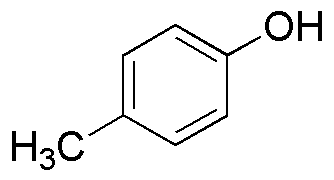p-Cresol is widely utilized in research focused on various applications across different industries. Here are five practical uses:
- Disinfectants and Antiseptics: p-Cresol is effective in formulating disinfectants due to its antimicrobial properties, making it valuable in healthcare settings for sanitizing surfaces and equipment.
- Phenolic Resins: This compound is a key ingredient in the production of phenolic resins, which are used in adhesives, coatings, and molded products, providing excellent heat resistance and durability.
- Laboratory Reagent: In research laboratories, p-Cresol serves as a reagent in organic synthesis, particularly in the production of various chemical compounds, enhancing efficiency in chemical reactions.
- Preservatives: It is utilized in the formulation of preservatives for wood and other materials, helping to prevent decay and extend the lifespan of products in construction and manufacturing.
- Pharmaceuticals: p-Cresol is used in the pharmaceutical industry as a solvent and in the synthesis of active pharmaceutical ingredients, contributing to the development of effective medications.
These applications highlight the versatility and importance of p-Cresol in various fields, addressing the needs of researchers and industry professionals alike.
General Information
Properties
Safety and Regulations
Applications
p-Cresol is widely utilized in research focused on various applications across different industries. Here are five practical uses:
- Disinfectants and Antiseptics: p-Cresol is effective in formulating disinfectants due to its antimicrobial properties, making it valuable in healthcare settings for sanitizing surfaces and equipment.
- Phenolic Resins: This compound is a key ingredient in the production of phenolic resins, which are used in adhesives, coatings, and molded products, providing excellent heat resistance and durability.
- Laboratory Reagent: In research laboratories, p-Cresol serves as a reagent in organic synthesis, particularly in the production of various chemical compounds, enhancing efficiency in chemical reactions.
- Preservatives: It is utilized in the formulation of preservatives for wood and other materials, helping to prevent decay and extend the lifespan of products in construction and manufacturing.
- Pharmaceuticals: p-Cresol is used in the pharmaceutical industry as a solvent and in the synthesis of active pharmaceutical ingredients, contributing to the development of effective medications.
These applications highlight the versatility and importance of p-Cresol in various fields, addressing the needs of researchers and industry professionals alike.
Documents
Safety Data Sheets (SDS)
The SDS provides comprehensive safety information on handling, storage, and disposal of the product.
Product Specification (PS)
The PS provides a comprehensive breakdown of the product’s properties, including chemical composition, physical state, purity, and storage requirements. It also details acceptable quality ranges and the product's intended applications.
Certificates of Analysis (COA)
Search for Certificates of Analysis (COA) by entering the products Lot Number. Lot and Batch Numbers can be found on a product’s label following the words ‘Lot’ or ‘Batch’.
*Catalog Number
*Lot Number
Certificates Of Origin (COO)
This COO confirms the country where the product was manufactured, and also details the materials and components used in it and whether it is derived from natural, synthetic, or other specific sources. This certificate may be required for customs, trade, and regulatory compliance.
*Catalog Number
*Lot Number
Safety Data Sheets (SDS)
The SDS provides comprehensive safety information on handling, storage, and disposal of the product.
DownloadProduct Specification (PS)
The PS provides a comprehensive breakdown of the product’s properties, including chemical composition, physical state, purity, and storage requirements. It also details acceptable quality ranges and the product's intended applications.
DownloadCertificates of Analysis (COA)
Search for Certificates of Analysis (COA) by entering the products Lot Number. Lot and Batch Numbers can be found on a product’s label following the words ‘Lot’ or ‘Batch’.
*Catalog Number
*Lot Number
Certificates Of Origin (COO)
This COO confirms the country where the product was manufactured, and also details the materials and components used in it and whether it is derived from natural, synthetic, or other specific sources. This certificate may be required for customs, trade, and regulatory compliance.


